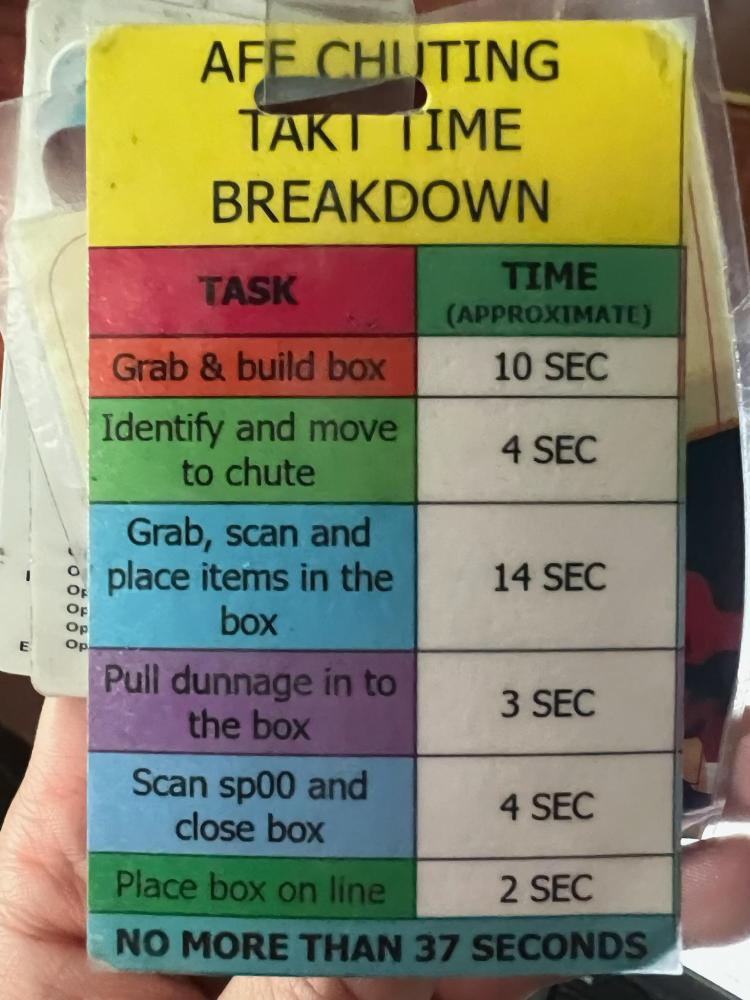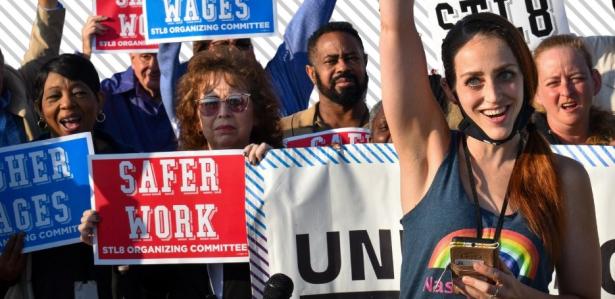Amazon workers at the STL8 fulfillment center in St. Peters, Missouri, filed an OSHA complaint August 3 against the company for health and safety violations in their warehouse. The complaint claims that the company deliberately discourages workers from receiving medical care when they are injured.
Workers say that AMCARE, Amazon’s in-house medical staff, repeatedly dismiss medical complaints and keep Amazon workers on the job despite sustaining sprains, torn ligaments, slipped discs, pinched nerves, and concussions.
Amazon employs more than 3,000 workers at STL8, northwest of St. Louis.
Wendy Taylor had been working at the facility for three years when she tripped and fell over an empty pallet that was left in her work path. She fell to the concrete floor face-first. Her nose was bleeding and her head was aching, but Wendy mostly remembers the terrible pain she felt in her leg.
Taylor was sent to AMCARE, where she was given a heat and ice pack for 30 minutes before AMCARE sent her back to work. Taylor says she asked to see a doctor multiple times, but was denied.
“They sent five different people at different times to try to talk me out of seeing a doctor. I felt bullied, I felt like I was being held against my will,” Taylor said. “All I wanted to do was get cared for, but they weren’t equipped.”
When Taylor finally went to a doctor’s office the next day, a nurse practitioner told Taylor that the swelling in her leg was immediately visible through her jeans.
Since March, Taylor has been in a battle with management to receive adequate accommodations for the long-term effects of her injury.
In a recent investigation, WIRED interviewed AMCARE staff at 12 different Amazon facilities. They found that management pushed on-site medical representatives (OMRs) to keep Amazon workers on the job and away from doctors. Former OMR Peter Torres told WIRED that managers directly instructed staff to decrease the number of Amazon employees they sent to the doctor, telling AMCARE staff that high injury rates made the company look bad.
UNION FLYERS
Unsafe working conditions, demanding production paces, low pay, and careless management led Wendy Taylor to join the union organizing committee at STL8 last year.
“When I heard someone had left flyers on cars in the parking lot about a union, I ran around trying to figure out what I could do, because I felt like this was the answer. If we come together in numbers and organize, and possibly form a union, we’ll have that power,” Taylor said.
Taylor has been organizing alongside fellow organizing committee member Jennifer Crane, another Amazon worker involved in the OSHA complaint at STL8. After her husband died in 2019, Crane was left a single mother of seven. Two of her oldest sons now work with her at Amazon, as they all struggle to keep their family afloat.
“Last June, there was a flier on the windshield of my car when I came out of work that said higher pay, safer work, an extra $10 an hour,” Crane said. She joined the organizing committee to fight for herself, her sons, and her co-workers.
Last October, Crane was trying to keep up with Amazon’s expected rate of packing 180 items per hour—one order every 37 seconds—when she felt pain shoot up her wrist. AMCARE told her it was just a sprain. When she came to work the following day, she could no longer feel her hand.
Amazon pressured Crane to go back to work. After paying out-of-pocket to see a specialist, Crane had to fight the company for worker’s compensation, which she was denied.

Jennifer Crane’s badge tells her how fast she is expected to work at STL8. Photo: Missouri Workers Center.
MARCHED ON BOSS
On May 23, Crane and about 20 of her co-workers marched on their boss to deliver a petition on health and safety. “We all met out front before the start of our shift and went straight to the [General Manager’s] office,” she said.
The petition demanded an independent safety audit of the building. They also demanded that management lower the work rate and create a safety committee led by workers to help with accommodations and worker’s compensation.
Crane reports that none of the demands have been met yet. Amazon did create a worker safety committee that meets once a month, but Crane says the selection process for workers who applied for the committee was opaque. None of the union organizing committee members who applied to be on the safety committee were accepted.
Crane, Taylor, and fellow STL8 organizer Paul Irving held a press conference with the Missouri Workers Center to discuss the OSHA complaint on August 3. They were joined by Missouri Congresswoman Cori Bush, former Deputy Assistant Secretary of Labor at OSHA Jordan Barab, and former chief of Occupational and Environmental Medicine at the University of Illinois Dr. Peter Orris.
“OSHA requires companies like Amazon to record injuries that occur in the workplace. Amazon has twice the rate of serious injuries of any other similar employer,” Barab said.
There’s no shortage of OSHA violations at Amazon. The company has faced citations at warehouses across the country, including an ongoing investigation in Washington state. However, these OSHA citations ultimately result in fines in the tens of thousands of dollars; the Washington OSHA citations amount to $81,000. The fines pale in comparison to the company’s operating expenses, which make it easy for Amazon to pay the fines without improving conditions.
To win meaningful change, workers have to organize. During the press conference, several speakers pointed to the need for collective action to win safer workplaces, as well as Amazon’s notorious union-busting designed to stop it.
STL8 workers aren’t the only ones organizing for health and safety improvements. Inland Empire Amazon Workers United, a group at the KSBD facility in San Bernardino, California, filed a complaint with Cal/OSHA (the state-wide OSHA body) in August. KSBD workers highlighted the company’s failure to protect ramp associates from extreme heat.
MANAGEMENT CODE RED
Rex Evans, a ramp worker at KSBD, said that two co-workers fainted during their shifts from heat exhaustion. That led him to take action. Evans started by posting on the Voice of the Associate (VoA) board, the online platform for Amazon workers to send questions to management. It can be viewed by other associates.
He asked why KSBD wasn’t following Cal/OSHA heat regulations for cool-down breaks in temperatures topping 110 degrees Fahrenheit. After an unsatisfactory response from management, he said he realized posting on the VoA board wouldn’t solve the problem—only acting together with co-workers could. With other organizing committee members, Evans helped put together a petition for air conditioning, living wages, and an end to retaliation from management for organizing.
“Every single person that goes to AMCARE has a negative experience,” Evans told me. “They’re not medically trained personnel—but they need to be.”
The petition was accompanied by an official complaint filed with Cal/OSHA. “CalOSHA responded by sending a representative a few days later,” IE Amazon Workers reported on their Instagram. Although the full investigation could take months, “their visit sent management into code red, scrambling to fix their mistakes.”
INJURED WORKERS UNITE
Other Amazon workers have taken a different approach. Forced out of the Amazon workforce after requesting accommodations for their disabilities, some former Amazon associates have taken to Facebook to try to organize for disability justice and improved health and safety conditions at Amazon.
One former Amazon worker, who requested anonymity for fear of retaliation, says she was terminated after working at an Amazon delivery station for 18 months. She had requested multiple times to be converted from a “flex” schedule, which changes weekly, to a consistent part-time schedule with limited hours to accommodate her disability. She believes she was denied due to her requests for disability accommodations. Eventually, her position was eliminated entirely.
From reading comments on Facebook, she realized that she wasn’t the only Amazon worker who had felt they experienced discrimination on the basis of requests for disability accommodations. So, she launched a Facebook group for Amazon associates with disabilities. The group began as a discussion thread for FMLA requests. Now they are coordinating OSHA complaints and reports to the Department of Justice to launch investigations into discrimination against workers with disabilities at Amazon.
“The laws that are set up are archaic,” the anonymous worker told me. “We’re working with a system that isn’t worker friendly, it’s business friendly. Amazon needs to admit that there’s a problem.”
Caitlyn Clark is a Teamsters for a Democratic Union organizer and a Labor Notes writing fellow.


Spread the word